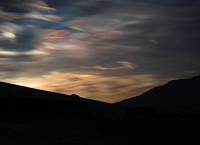Discovery of the ozone hole
Jonathan Shanklin, Meteorologist at the British Antarctic Survey, was one of the team that discovered the ozone hole in 1985.
In this video, Jonathan reveals how this significant discovery was made and talks about the effectiveness of an international treaty, the Montreal Protocol, which places strict controls on ozone-destroying substances.
Why is the ozone layer important?
For almost a billion years the ozone layer around the Earth has protected life from the effects of ultraviolet rays. It is in the stratosphere, 10-40km above the Earth’s surface and can partially absorb cancer-causing UV-B rays from the Sun.
What is happening to the ozone layer?
For several decades we have been releasing chemicals such as chlorofluorocarbons (CFCs) into the atmosphere that can destroy ozone. In most parts of the world there is little damage to the ozone layer but a huge hole develops over Antarctica every year in the polar winter.

Spectacular nacreous clouds form in very cold temperatures (below -78°C) at very high altitudes (between about 14 and 20km). © Julie / Antarctic Heritage Trust
In the most extreme Antarctic conditions, below -78°C, nacreous clouds (wispy-looking iridescent clouds) form in the stratosphere. A chemical reaction takes place in these clouds converting chlorine from the CFCs into an active form that destroys ozone. Each spring, when temperatures rise again, the hole disappears.
Will the ozone hole recover?
After the British Antarctic Survey team discovered the Antarctic ozone hole in 1985, the Montreal Protocol was set up, controlling the manufacture and release of ozone-depleting substances.
Today, the amount of these substances being released into the atmosphere is declining and there is evidence to suggest the rate of ozone decline is slowing. However, it will probably be the middle of this century or beyond before we can finally say, ‘That was the last ozone hole’.